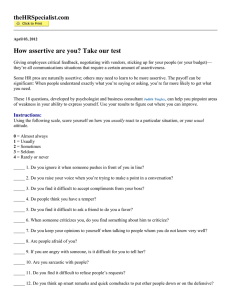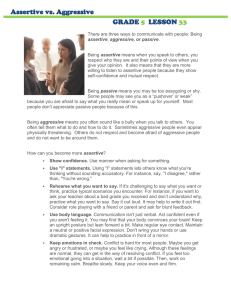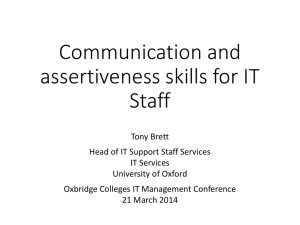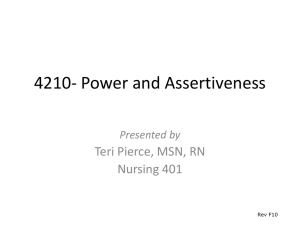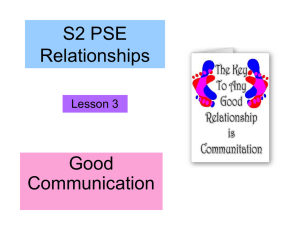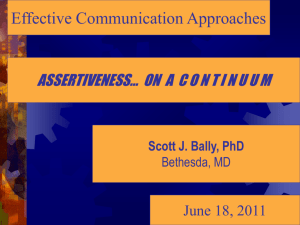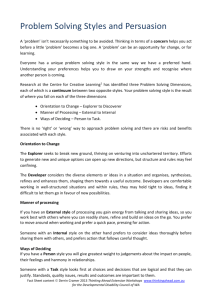Self-directed learning: managing yourself and your working relationships
advertisement
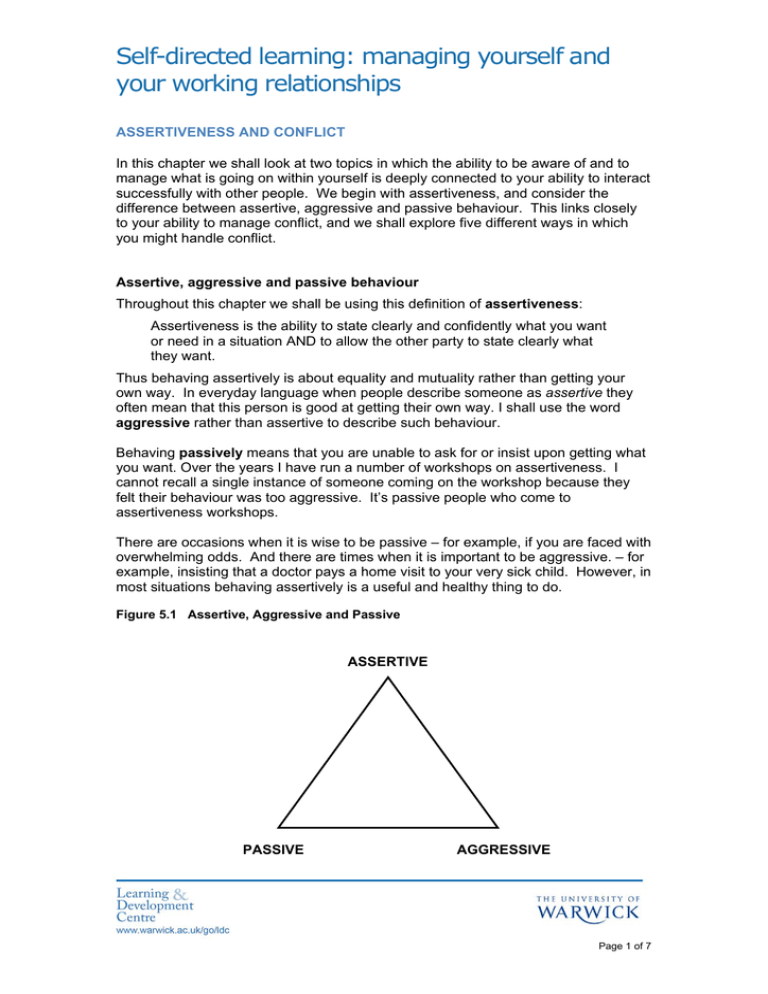
Self-directed learning: managing yourself and your working relationships ASSERTIVENESS AND CONFLICT In this chapter we shall look at two topics in which the ability to be aware of and to manage what is going on within yourself is deeply connected to your ability to interact successfully with other people. We begin with assertiveness, and consider the difference between assertive, aggressive and passive behaviour. This links closely to your ability to manage conflict, and we shall explore five different ways in which you might handle conflict. Assertive, aggressive and passive behaviour Throughout this chapter we shall be using this definition of assertiveness: Assertiveness is the ability to state clearly and confidently what you want or need in a situation AND to allow the other party to state clearly what they want. Thus behaving assertively is about equality and mutuality rather than getting your own way. In everyday language when people describe someone as assertive they often mean that this person is good at getting their own way. I shall use the word aggressive rather than assertive to describe such behaviour. Behaving passively means that you are unable to ask for or insist upon getting what you want. Over the years I have run a number of workshops on assertiveness. I cannot recall a single instance of someone coming on the workshop because they felt their behaviour was too aggressive. It’s passive people who come to assertiveness workshops. There are occasions when it is wise to be passive – for example, if you are faced with overwhelming odds. And there are times when it is important to be aggressive. – for example, insisting that a doctor pays a home visit to your very sick child. However, in most situations behaving assertively is a useful and healthy thing to do. Figure 5.1 Assertive, Aggressive and Passive ASSERTIVE PASSIVE AGGRESSIVE Page 1 of 7 Self-directed learning: managing yourself and your working relationships People who find it difficult to be assertive frequently find it hard to say No to any request. This may then lead to problems with time management, finding a desirable work-life balance, or stress. One of the classic books on assertiveness has the title When I Say No I Feel Guilty. This suggests that problems in being assertive may have their roots deep in someone’s early experiences and personality. However, we won’t be looking at these ideas in a psychodynamic or therapeutic way. Rather, as with the other ideas explored in the book, we introduce the notion of assertiveness to invite you, first, to think about your situation with a fresh eye and then, if you choose, to behave differently. Basic assertiveness An alternative term for aggressiveness in this context is basic assertiveness. Basic assertiveness might be defined as the first half of the above definition - the ability to state clearly and confidently what you want or need in a situation. When you behave with basic assertiveness, you do not take into account the needs of the other party. As an illustration, you might take a basic assertive stance when returning a faulty item to a shop. Hopefully you treat the shop assistant courteously, but you are not concerned about the relationship between you, which is a very temporary one, nor with their needs. If, however, you are dealing with a work colleague – a longstanding client, one of your staff or your boss, for example – then the relationship matters and it is extremely useful if you can behave with genuine assertiveness in this relationship. Another way of summarising this is that assertiveness is a two-way street whereas aggressiveness or basic assertiveness is a one-way street. One technique which can be helpful when you wish to be basically assertive is known as the broken record. The metaphor comes from the time when recorded music was played back on black, vinyl records. Sometimes, if the record was slightly damaged, the needle on the record player would become stuck and the same small piece of the song would be played back repeatedly. When you use the broken record technique you simply repeat the same phrase in response to whatever objection the other party makes. As an example, if you are returning a faulty item to a shop repeatedly stating This item is faulty and I want my money back can be very hard for the other person to resist. Page 2 of 7 Self-directed learning: managing yourself and your working relationships Rights and responsibilities A useful idea in assertiveness is the notion of rights. As a human being, you have rights, such as the right to: • • • • • • • • State your opinion Get what you pay for Ask for what you want Say No Change your mind Make a mistake Be treated with respect Choose not to assert yourself Even though you have less authority and power than the chief executive of your organisation, nevertheless as human beings the two of you are equal. As an exercise, you might like to consider which of these rights you find it difficult to permit yourself. Alongside these rights you also have responsibilities, and you have to live with the consequences of your actions. For example, you might say No when your manager asks you to work overtime because you have an important private engagement that evening. However, if you regularly say No to reasonable requests from your boss, then you may find yourself having to look for a new job. Similarly, if you frequently change your mind, then you will soon acquire a reputation for being unreliable. One way in which I sometimes work with a coaching client who is having difficulties in being assertive is to invite them to rehearse with me a conversation they would like to have with someone but which they are putting off. An idea that may help them to speak assertively is to explain the reasons behind their views or to state why something is important to them. It can also be powerful to state how they feel about a situation. The client might prepare and then deliver their assertive statement, and together we review how they performed. I generally ask the client to give themself feedback before adding any comments of my own. Then the client has another go, building in their learning from the review. Stating your views together with the thinking or emotion behind your views can be very assertive. One thing which often emerges in such a rehearsal is the importance of body language and tone of voice in speaking assertively. Assertive people take space – literally and metaphorically – to deliver their message. If you watch someone like Barack Obama giving a speech you will notice that he actually speaks very slowly, taking lots of time and space to give his message. When someone who has behaved passively for many years begins to behave more assertively, this can seem to them to be aggressive. It can also surprise other people around them who may have benefited from that person’s lack of assertiveness in the past. The idea of Passive, Aggressive and Assertive behaviour links to some of the other models explored in this book. For example, someone struggling to be assertive with Page 3 of 7 Self-directed learning: managing yourself and your working relationships a manager or colleague may, in Transactional Analysis terms, be in an Adapted Child ego state in response to the other person’s Critical Parent. I think that a lot of Passive behaviour takes place when someone is in the Adapted Child ego state. Handling Conflict We turn now to consider how Passive, Aggressive and Assertive behaviour relates to different ways of handling conflict. I find the following short definition very useful: Conflict is any form of disagreement, no matter how large or small. As figure 5.2 indicates, conflict which isn’t addressed can escalate over time. What starts as mild irritation may become annoyance, perhaps leading to anger and possibly violence. Hence, it is easier to tackle conflict in its early stages, though we often settle for an easy life, say nothing, and hope that the disagreement will go away or resolve itself. Figure 5.2 Conflict may escalate VIOLENCE ANGER ANNOYANCE IRRITATION When a coaching client describes their situation as a disagreement or conflict with a colleague or manager, I am likely to draw the diagram in Figure 5.3 which shows five possible styles of handling conflict. This was originally described by two writers, Kenneth Thomas and Ralph Kilmann, and the framework is known as the ThomasKilmann model. Page 4 of 7 Self-directed learning: managing yourself and your working relationships The five styles depend on whether you attempt to satisfy the needs of your self or the needs of the other party. • If you seek to satisfy your own needs and disregard the needs of the other party, then the style is described as competing. • However, if you give priority to satisfying the needs of the other person and disregard your own needs, then this is described as accommodating. • If you make no attempt to satisfy ether your own or the other party’s needs, then this is referred to as avoiding. • On the other hand, if you endeavour to meet both your own needs and the needs of the other person, this is called collaborating. • Finally, if you seek to meet some of your needs and some of the other party’s – splitting the difference in some way, as it were - then this is called compromising. Figure 5.3 Five ways of handling conflict NEEDS OF OTHERS ACCOMMODATING COLLABORATING COMPROMISING AVOIDING COMPETING NEEDS OF SELF Page 5 of 7 Self-directed learning: managing yourself and your working relationships Let’s illustrate the five styles with a simple example where there is an orange available to you and me. • • • • • If we are both too embarrassed to say we would like the orange, then neither of us gets it and we are avoiding. If I simply hand over the orange to you, I am accommodating If I arm wrestle with you to win the orange for myself, I am competing. If we cut the orange in two (not necessarily equal) parts and share it, we are compromising. If we explore why each of us wants the orange and realise that you need only the flesh for juice while I need only the peel, then we can both get what we want and we are collaborating. It is important to note that each of these styles can be appropriate depending on the situation. • If we are in a situation where the outcome is very important to you but not particularly important to me, then I might usefully decide to accommodate your wishes. • On the other hand, if it is really important to me to have my needs met – for instance, I may have applied for a job that I really want – then I need to compete to try to win. • If I have absolutely no chance of getting what I want, then it would be wise to avoid the conflict. Or, if there is no chance of reaching agreement today but a good chance of agreeing next time we meet, then I might avoid the issue for the time being. • Some situations lend themselves naturally to compromise. Negotiations – for instance, between management and trade unions – often go through somewhat ritualistically offer and counter offer before a compromise is reached. For instance, management offers a 2% pay rise, the union demands 10%, and a settlement of 4% is agreed in due course. • There are times when it may be very important to seek a collaborative outcome. For example, if you and I hope to establish a long term business partnership, then it may be vital that we explore in depth what each of us seeks from the arrangement and only agree when we both feel satisfied that our needs are being well served. Note that is often isn’t possible to reach a collaborative agreement – wage bargaining might well be one such situation. The person who is best equipped to handle conflict well is one who can use all of the styles effectively and when appropriate. The different styles of handling conflict are related to the idea of Passive, Assertive and Aggressive behaviours that we looked at in the previous section. Behaving passively means that you don’t attempt to meet your needs, which equates to avoiding or accommodating. Aggressive behaviour – or what we called basic Page 6 of 7 Self-directed learning: managing yourself and your working relationships assertiveness - is similar to competing to get what you want. And being genuinely assertive is required in seeking a collaborative outcome where we are both satisfied. The styles are also linked to notions of winning and losing. Collaboration is a search for a win – win outcome. In avoiding we both lose as the situation is not resolved. Competing can be viewed as win – lose, while accommodating is lose – win. The Thomas-Kilmann Conflict Mode Instrument can be purchased easily on the internet. It poses thirty pairs of statements describing how you might respond in a situation where your wishes differ from another person’s. From each pair you choose the response that is most characteristic of your behaviour. For example, choose which of these two statements is most typical of you: A. B. I try to find a compromise solution. I sometimes sacrifice my own wishes for the wishes of the other person. You then self score the questionnaire to identify your preferred conflict handling style. I find that people have difficulty choosing their typical response to many of the questionnaire items, so that the instrument itself is of limited help. However, I think the Thomas-Kilmann model is a really useful framework to help you think about how you handle conflict and how you might behave differently. Page 7 of 7

